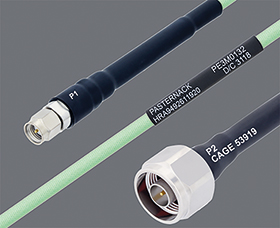

There are many applications, some emerging, that require both phase and amplitude error to be minimised. These applications include synthetic aperture radar using antenna arrays, beamforming/MIMO antenna arrays for communications, actively electronically scanned array (AESA) radar, satellite communications, interference friend or foe (IFF) radar and many other applications. Many of these applications must also place the antennas and cable assemblies that connect the antennas to the transmit/receive circuitry in harsh environments or operating conditions.
Due to the nature of dielectric materials and coaxial assembly construction, cable assemblies experiencing extreme temperature variations can deform. This temperature related deformation can cause increased insertion loss, VSWR degradation and lead to changes in the phase delay of a cable assembly. Air-gaps can even form if the cable assembly isn’t designed correctly and the dielectric material ‘backs-out’ of the connector.
Though some of the thermal degradation is unavoidable, such as the expansion/contraction of inner and outer conductor metal at various temperatures, there are ways to condition a coaxial cable assembly to minimise these temperature related effects. One method to enhance the reliability of coaxial cable assemblies for high temperature variability applications is to thermally pre-condition an assembly that is designed to undergo such treatment.
Temperature conditioned coaxial cable assemblies can also be made to meet military/defence and aerospace standards to offer enhanced high-reliability (Hi-Rel) features. Other design features, such as additional shielding and captivated connector styles, can be used to further enhance the reliability of temperature conditioned coaxial cable assemblies. The result is a cable assembly that is both physically and electrically reliable over time as well as temperature.
Main features of temperatureconditioned RF cable assemblies:
• Thermally pre-conditioned (to ensure thermally stable behaviour).
• Built using expanded PTFE low-loss coaxial cable.
• Triple shielded coaxial cable.
• Captivated stainless steel RF connectors.
• J-STD soldering assembly build process and WHMA-A-620 workmanship criteria.
• Lot traceability for all materials.
Key applications include avionics, military electronics, IFF, SATCOM, ECM, industrial/manufacturing, oil/gas and other high-temperature working environments.
| Tel: | +27 21 555 8400 |
| Email: | [email protected] |
| www: | www.rfdesign.co.za |
| Articles: | More information and articles about RF Design |
© Technews Publishing (Pty) Ltd | All Rights Reserved